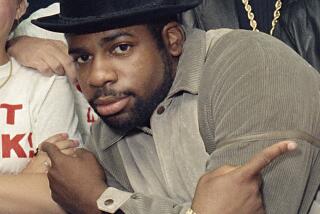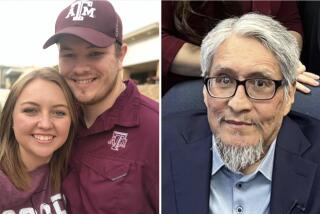Jury Finds Layton Guilty in ’78 Jonestown Murders
SAN FRANCISCO — Former Peoples Temple member Larry John Layton was convicted Monday of conspiring to kill a U.S. congressman and a diplomat in a 1978 jungle ambush that led to a mass murder-suicide at the cult’s Jonestown commune.
More than 900 people took poison or were shot that day--Nov. 18, 1978--just hours after a squad of cult members armed with handguns and rifles attacked a party headed by Rep. Leo Ryan (D-San Mateo), who journeyed to the South American nation of Guyana to investigate the cult.
Ryan, three journalists and a cult defector were killed in the ambush, while diplomat Richard C. Dwyer and 10 others were wounded. The ambush and subsequent mass killings at the commune several miles away were ordered by cult leader Jim Jones, who believed that his group was under attack by the CIA.
Layton, the only person ever to stand trial in the United States in connection with the Jonestown massacre, was convicted on two counts each of the federal crimes of conspiracy to murder and aiding and abetting the murder of a congressman and an “internationally protected person”: Dwyer, who was then the deputy chief of the United States mission to Guyana.
Although not charged with actually shooting either man, Layton, 40, faces a maximum penalty of life in prison. Sentencing is scheduled for Jan. 23. Layton had been free on bail since a 1981 mistrial, but was ordered jailed by Chief U.S. District Judge Robert F. Peckham after the jury found him guilty.
Defense lawyer Tony Tamburello of San Francisco, who did not offer a defense on the grounds that the prosecution’s case was so circumstantial, called the verdict “incomprehensible” and promised an appeal.
Decision Criticized
He declined to discuss the substance of any possible appeal, but alleged that he was denied classified government documents that may have aided his defense. Prosecutors flatly denied that this was so.
In any case, Tamburello angrily criticized Peckham’s decision to jail Layton until he is sentenced, calling it “a tragedy compounded on tragedy.”
That prompted a sharp reaction from U.S. Atty. Joseph P. Russoniello. “The man is a convicted murderer as he stands before the court now,” the prosecutor said, “and the United States is going to resist any effort to release him just because someone says he’s been a good guy (while free on bail) for the last five years.”
Russoniello said the government’s persistence in prosecuting Layton--the eight-year case was one of the lengthiest federal prosecutions he could recall--was justified by the verdict.
Grim Disbelief
As the verdict was read Monday, Layton sat at the defense table, a look of grim disbelief on his face. Tamburello laid a comforting hand on his client’s shoulder. A somber-faced Russoniello turned and shook the hand of his co-prosecutor, Assistant U.S. Atty. Mike Nerney.
When Russoniello asked that Layton be held in custody until sentencing, one of Layton’s relatives sitting in the front row of the spectator’s gallery said aloud, “Oh, you . . . “ and then started sobbing. “Where are they taking him?” she cried as Layton was led from the courtroom.
Jury foreman Ronald Iskow, 34, of San Mateo, said jurors were evenly split when they began their 25 hours of deliberations Nov. 20. By Wednesday, they were divided 11 to 1 in favor of conviction; the lone holdout asked for time over the long holiday weekend to review his notes on the case.
When the jurors returned Monday, however, they finished their deliberations rapidly.
“Once we had (a guilty verdict on) that first count of conspiracy, the others followed quickly,” Iskow said. “A couple of jurors had a real hard time emotionally (dealing with memories of the mass killings), and we had to keep saying to them that that shouldn’t affect the verdict.”
Signed a Confession
Guyanese authorities arrested Layton shortly after the killings, and Layton signed a confession taking responsibility for all the deaths at the airstrip. He was acquitted in Guyana on charges of attempted murder but was then brought back to the United States to face trial on charges involving Ryan and Dwyer, whose shootings were federal crimes.
A 1981 trial in U.S. District Court here ended in a mistrial, with the jury deadlocked 11 to 1 in support of acquittal on the conspiracy counts and 7 to 5 in favor of conviction on the aiding-and-abetting charges.
The second trial was delayed five years while federal prosecutors appealed earlier court rulings that prevented the use of some evidence, including tape recordings of cult leader Jim Jones’ exhorting followers to commit ritual mass suicide.
Higher courts determined that the material was admissible, but parts of the tape were again excluded as immaterial by Peckham, who has presided over both trials.
The verdict in Layton’s second trial was handed down little more than eight years after the bloody jungle ambush and subsequent mass murder-suicide that shocked the world.
Held Against Will
Ryan and Dwyer led a group of their staff aides and reporters to Jonestown to investigate complaints from some of Ryan’s constituents that the cult held some members against their will. As the party, now including 18 temple defectors, prepared to fly out from a small jungle airstrip, a tractor pulled a trailer full of armed men onto the runway.
Without warning, the men--temple devotees--started shooting.
Iskow, the jury foreman, said a key to the guilty verdict was the testimony that the gunmen fired only at the larger of the two craft--the plane carrying Ryan, but not Layton.
“That was a major factor in our minds,” Iskow said. “The fact that he insisted on being on that (other) plane.”
Layton, a Peoples Temple member since 1968, conceded that he had posed as a defector and used a handgun to shoot and wound two real defectors during the attack. Those were the shootings for which he was tried in Guyana.
Conspiracy Denied
Despite that admission, Layton denied he was part of an ambush conspiracy or had any advance knowledge of plans to kill the congressman or the diplomat.
The bloody attack apparently was intended to prevent the Ryan party and the reporters from returning to the United States with evidence of problems at the outwardly Utopian commune.
In addition to Ryan, the dead included San Francisco Examiner photographer Greg Robinson, NBC reporter Don Harris, NBC cameraman Robert Brown and cult defector Patricia Parks.
Immediately after the airport ambush, Jones, who apparently believed that Ryan had been sent by the CIA, became convinced that the United States would retaliate. He ordered all commune members--including many small children and entire families--to drink cyanide-laced fruit punch. Those who refused were shot to death.
913 Died
Although 79 people escaped alive, 913 did not. Jones’ body was found with a gunshot wound to the head. It was never determined whether the wound was self-inflicted.
Peoples Temple was an idealistic quasi-religious cult--an offshoot of the Disciples of Christ, a mainstream Protestant denomination--that promised its members freedom from poverty, racism and other social ills.
Jones began the temple in Indianapolis in the late 1950s and moved to Ukiah in rural Northern California in 1965. He moved again to San Francisco in 1970, and recruited heavily from black neighborhoods in San Francisco and Oakland.
Jones claimed in 1976 that he had 10,000 followers, but disaffected former members put the total number of adherents at closer to a maximum of 3,500.
Several leading politicians at the time praised its work in aiding the poor and giving people confidence in their futures. But critical news accounts and complaints from relatives of temple members prompted the temple in 1977 to move to Guyana, a former British colony on the northeast coast of South America.
Group Allegedly Watched
U.S. State Department officials in Guyana allegedly kept watch on the group at its rough-hewn isolated commune, called Jonestown. Tamburello contended in his closing argument that the government should have warned Ryan in advance of the potential for violence.
Tamburello said his client was made a “scapegoat” because of that alleged oversight and because no one else ever was charged with a crime in the bizarre episode.
Federal prosecutors, meanwhile, offered jurors Layton’s signed confession--which Tamburello discounted as coerced--and testimony from some former temple members that Layton was a close confidant of Jones and was seen talking to the cult leader immediately before going to the airport.
Russoniello said in his closing argument last week that Layton may have been a “minor player” in the day’s events and may not have specifically known all the details of the planned ambush. But Russoniello argued that Layton was guilty nonetheless because he knew some sort of attack would take place and did nothing to prevent it.
More to Read
Sign up for Essential California
The most important California stories and recommendations in your inbox every morning.
You may occasionally receive promotional content from the Los Angeles Times.










